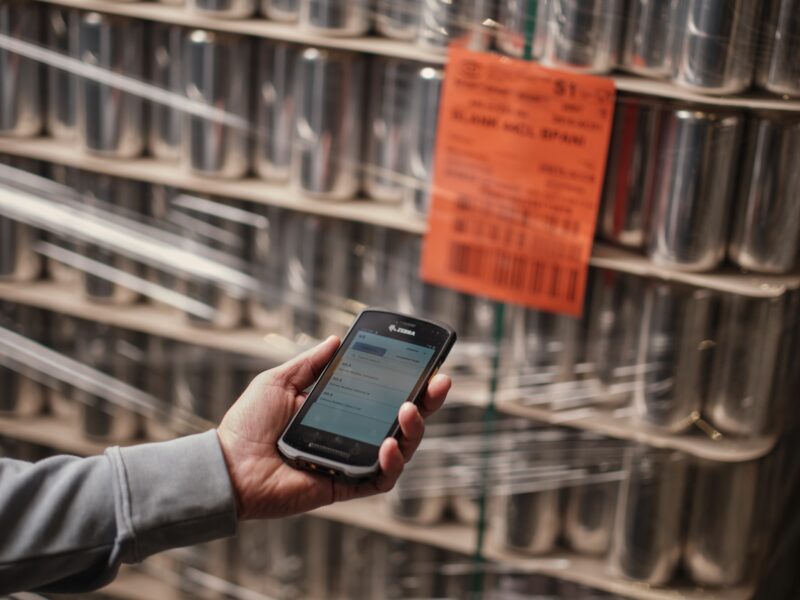Everything you need to know about inventory tracking

Ioana Neamt

As of 2024, there are between 12 and 24 million online businesses globally. With so much competition and just one chance to make an impression that leaves customers coming back, you need to make the shopping experience as seamless as possible. One way to do that is with inventory tracking.
Having a salient inventory tracking strategy means your customers can easily find which of your products are in stock and receive their orders quickly. This might make all the difference between ordering from you or a competitor.
The longer you go without meticulously tracking your inventory, the more likely you’ll struggle to sell your products online. Luckily, this article will outline everything you need to know about inventory tracking, including the best software to use for your small company.
What is inventory tracking?

Inventory tracking is simply the method of monitoring your different types of stock, whether it’s how much you have available or where it is. The numbers you have will change daily as new orders come in and get shipped.
Plenty of smaller businesses will use Excel spreadsheets to keep track of their inventory, but this comes with its own problems. For one, inputting numbers is bound to lead to human error and be time-consuming — and time is usually in short supply for small business owners.
Using inventory tracking software makes life easier for small businesses and large enterprises alike. It allows you to automatically keep track of all your stock and will send alerts when certain products are low.
Benefits of inventory tracking
Taking the steps to track your business inventory comes with a host of advantages. One is that knowing how many products you have in stock and how many are on order will save you time and money. Let’s go over some additional advantages of having an inventory tracking strategy in place.

Avoid wasting resources on storing excess stock
It costs money to store inventory, so keeping excess stock will make you less profitable in the long run. Keeping a tight leash on your inventory levels will allow you to optimize your operations — you’ll only keep stock needed to fulfill sales.
Monitor any damaged products
Tracking your inventory allows you to keep a close eye on the condition of your products, meaning you can monitor how much of your inventory is getting damaged.
Speed up your order processing
To have any chance of competing against other online stores, you need to ship your orders to customers speedily. Inventory tracking allows you to pinpoint your product locations quickly and send them out to customers, increasing their satisfaction with your business.
Better understand your sales patterns
Demand forecasting is an important part of managing your business and its supply chain. Inventory tracking allows you to get a better insight into ordering trends so that you can prepare for high-demand periods.

Challenges of inventory tracking
Tracking inventory accurately comes with its challenges. Even with the help of inventory tracking software, keeping an eye on thousands of products won’t be easy. Here are some of the main challenges you can expect as you start inventory tracking.
It’s time-consuming
While reverting to software over manual tracking will save you a lot of time, it can still be complex — especially as your online business grows and you start taking more and more orders.
Tracking individual items is difficult
If you’re selling multiple products or storing them in different warehouses, staying on top of each and every time in your inventory will be tricky, even with an inventory tracking system.
It’s hard to maintain accuracy
Inventory management needs to be accurate to work. Small errors are natural, but if you see huge discrepancies between your tracked and actual stock, your system may be flawed. Minimizing differences between your financial records and your recorded stock may take some trial and error, making it time-consuming.
What is an inventory tracking system?
Inventory tracking systems are tools that work by helping your business keep an eye on its products.
Imagine you own a small store, and you need to know how many items you have in stock, what’s selling fast, and what needs to be reordered. An inventory tracking system does all this for you.
Here’s how it works:
- It keeps count for you — It records every item that comes in and goes out, so you always know how much stock you have.
- It alerts you — It can notify you when you’re running low on something so you can reorder before you run out.
- It reduces the chance of errors — Automating the counting and tracking process reduces the chances of mistakes that can happen with manual counting.
- It saves you time — Instead of spending hours checking shelves and counting items, you can quickly see everything in the system.
- It improves your planning process — It helps you understand which products are popular and which are not so you can make better decisions about what to stock up on.
In short, an inventory tracking system makes managing your stock easier, saves you time, and helps you keep your customers happy by ensuring you always have what they need.
Examples of inventory tracking methods
There are plenty of different methods available for tracking your business’ inventory, some more effective than others.
Traditional spreadsheets
Using a spreadsheet, either Excel or Google Sheets, is the most cost-effective way to track your inventory and is typically used by smaller businesses. This method is okay if you have a smaller inventory, but as your business grows, you might want to move on to automated tracking.
With a traditional spreadsheet, you simply need to manually input the SKU number, item name, inventory location, stock, orders placed, and the delivery due date.
Two-bin rotation
The two-bin rotation system, also known as a two-bay system, is when online stores have two different storage points where they keep their stock—typically on the shelves of their store and in a storage facility.
As shelf inventory is sold, stock from storage is then moved to the shelf. Because it doesn’t rely on tech to work, it’s a relatively cost-effective way to practice inventory management.
Barcode systems
A barcode system helps online stores keep track of their products using their barcodes, all done by computer software. When new items arrive at the warehouse, each product’s barcode is scanned, telling the system that these items are now in stock.
As soon as the product is scanned, the system updates itself right away. That way, the online store always knows exactly how much of each item there is. When shipped, the barcode is scanned again before packing so the system can update.
RFID systems
RFID systems work in a similar way to barcode systems in that they use small tags that collaborate with computer software.
In this system, each product is fitted with a small radio frequency tag containing key information about the item. So, when new products arrive at the warehouse, your employees can quickly scan these tags using RFID readers and continue to track them on their journey from shipping to arriving at the customer’s door.
Because your business will need to fund multiple components including the RFID tags, scanners, and the computer software itself, this can be a far more expensive method for inventory tracking.

Inventory tracking software
Utilizing inventory tracking software is the most sophisticated way to keep a close eye on your products. Unlike a spreadsheet or a two-bin rotation, this software doesn’t just keep track of what’s coming into your warehouse and where it goes — it uses tech to provide updates on shipping in real-time, as well as ordering patterns.
This handy tech lets you:
- Instant visibility of your inventory levels, done in real-time
- Automatic inputting of your inventory data so you don’t need to lift a finger
- Processes orders for you by tracking all incoming orders and creating packing lists
- Sets reorder points and generates alerts to let you know when your stock is running out
- Identifies slow-moving stock so you can adapt your inventory levels and save money on warehouse costs
Inventory tracking software is the ultimate tool for managing your products. Unlike manual systems, software not only inputs and manages orders for you — it also gives you insights into patterns associated with your stock, like Katana.
Improve inventory tracking efficiency with Katana
If you’re looking for the number one inventory tracking software on the market, look no further than Katana. Our cloud-based system provides real-time data to optimize all your inventory levels, allowing you to make better decisions about how much stock you hold on to.
At Katana, we understand that the future of sales is both flexible and multichannel. Our software gives you total visibility of your inventory by centralizing your order fulfillment from all your sales channels in one place.
To find out more about how Katana can help your business, request a demo today!
FAQs
Unlike traditional methods for tracking inventory (like spreadsheets or two-bin rotation), inventory tracking software automates the input of data. It uses this to give you real-time insights into your inventory so you can avoid expensive issues like stockouts. It’s also a cheaper method compared to barcode or RFID systems.
Inventory tracking is important for smaller businesses as it allows you to gain insight into your stock trends so you can adapt your strategy to avoid issues like overstocking or understocking.
It also helps to:
- Prevent stockouts
- Optimize your inventory turnover
- Improve customer satisfaction
- Speed up the ordering process
Katana inventory management software specializes in helping you forecast future demand by analyzing historical data and identifying patterns in your previous orders. With this data, the software will help you better predict customer demand and order the right amount of stock to prevent costly stockouts.

Ioana Neamt
Table of contents
Get inventory trends, news, and tips every month
Get visibility over your sales and stock
Wave goodbye to uncertainty with Katana Cloud Inventory — AI-powered for total inventory control